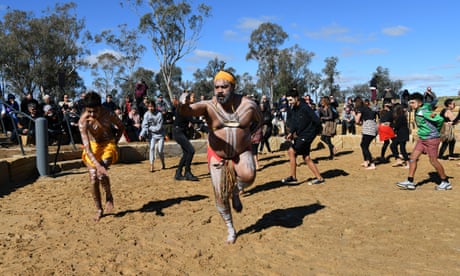- by foxnews
- 04 Apr 2025
‘Not calling a massacre a massacre is ridiculous’: a model of truth-telling at Myall Creek
‘Not calling a massacre a massacre is ridiculous’: a model of truth-telling at Myall Creek
- by theguardian
- 03 May 2022
- in news

Each year, high school teacher and artist Adele Chapman-Burgess takes her year eight class to the Myall Creek memorial in north-east New South Wales. It was here, in June 1838, that at least 28 Wirrayaraay people were killed in a massacre by white stockmen, their bodies later piled up and burned.
The students are "blown away when they see the memorial", she says, which includes a walking trail and a large stone with a brass plaque, on which a vandal at one point scratched out the word "murdered".
The Myall Creek murders set a judicial precedent: seven stockmen were convicted of the deaths and hanged six months later, although one free settler among the perpetrators evaded capture, living comfortably in plain sight for the rest of his life. A further four defendants walked free, after an Aboriginal eyewitness mysteriously disappeared.
The massacres that claimed thousands of Aboriginal men, women and children's lives across Australia between 1788 and 1930 continue to be mapped by the University of Newcastle and Guardian Australia, but largely went unpunished at the time.
Speakers at a truth-telling panel on the Myall Creek massacre, hosted on Saturday by the Arts and Cultural Exchange at Parramatta, criticised an "ignorance" among many Australians about our frontier history, calling for more education of teachers and students, as well as greater Indigenous self-determination of the terms on which historical truths can be told.
Panellist Chapman-Burgess, a Ngarrabul/Gamilaraay/Yuwaalaray/Kooma woman - and a descendant of the same language group as the Wirrayaraay - called on universities to "step up" by expanding their "tokenistic" Aboriginal histories modules so that teachers can "feel comfortable talking about Aboriginal history, culture and telling the truth".
Chapman-Burgess is a member of the national committee of the friends of Myall Creek, which includes descendants of the massacre's perpetrators, victims and survivors. Each June they meet at the site in reconciliation, to light commemorative candles and acknowledge inter-generational trauma.
Keith Munro is co-chair of the committee. He says having descendants of both sides come together each of the past 22 years sets an example for effective reconciliation. "It's not just our history, it's also your history. As 10th generation Australians, there is no separation, there is no us and them."
Saturday's panel spoke of the continuing denial that massacres took place in Australia, and the pressure to use euphemisms in the education system. Chapman-Burgess said her school executive has fielded phone calls of objection (she doesn't say from whom) asking her to avoid the word "massacre" on student permission slips to attend the memorial. "Sorry, no," she tells them, adding her school backs her up.
There are plans to add an educational and memorial keeping place for artefacts at Myall Creek, provided funding can be secured. This might mean a permanent home for a 30-panel Myall Creek gathering cloak made by community artists on possum skins, which tells songline stories around water, originally created for a 2018 exhibition and currently on display at Sydney's National Art School as part of Sydney Biennale.
Another panellist, Dharug man Chris Tobin, noted that despite the plethora of cenotaphs and statues for Australians fighting overseas, there was until recent times "nothing" for Aboriginal people "who fought to defend their own country".
This fact propelled a reconciliation group, of which Tobin was a part, to approach the St John of God hospital to erect a memorial at a massacre site at Richmond Hill, where a battle took place in 1795 between Dharug people and the New South Wales Corps. "Don't wait for the government," he said. "Bugger waiting for the government."
Memorials are "more meaningful" when put together by Aboriginal groups in consultation with community, said Dharug panellist Julie Bakari Webb. "That's our traditional right under lore and business," she said. "That's not the place of government or councils or anyone else to be able to tell us how to memorialise."
In 2017, the Uluru Statement from the Heart was released, which called for a constitutionally enshrined First Nations voice to parliament and a Makarrata commission "to supervise a process of agreement-making between governments and First Nations and truth-telling about our history".
"Governments have really struggled since the day dot to establish a genuine relationship with Aboriginal people," said Keith Munro. "The ignorance in regard to our frontier history can also be echoed in the ignorance a lot of Australians have to just simple things, like how Aboriginal funding actually works. [Most funding for Aboriginal programs] gets chewed up in administrative costs."
- by foxnews
- descember 09, 2016
'I traveled for an entire year for free - and saved $15K'
Hailey Learmonth explored Australia without paying rent, thanks to pet sitting. She saved $15,000, lived on farms, and embraced remote work to travel on a budget.
read more


